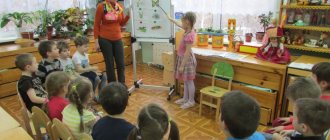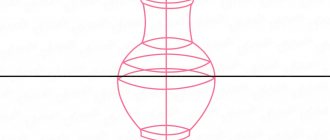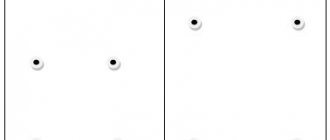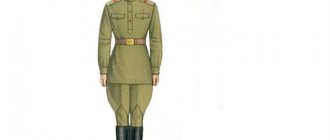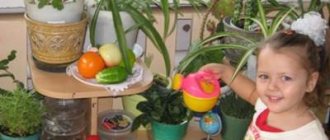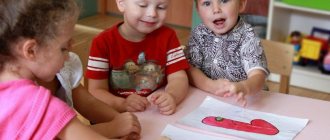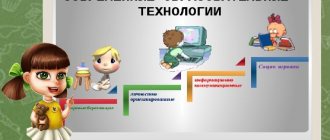What material is given on FEMP in the senior group
FEMP in the senior group is focused on broadening one’s horizons, applying the acquired knowledge to everyday life, and having a correct understanding of the world.
Throughout the entire school year at preschool educational institutions, children learn new geometric shapes. By the end of the third quarter, children should distinguish the following shapes: circle, triangle, square, rectangle, oval. Also, ideas about a ball, cube and cylinder are introduced and reinforced. Classes are conducted aimed at training in dividing a circle and square into two and four parts.
Children in the senior group of preschool educational institutions
After division, everyone should be able to name and describe the resulting figures. The children learn to apply the acquired knowledge in geometry in life: they visually select objects of familiar shapes, tell how they are used: for example, they analyze a sheet of paper, determining what shape it is, where its corners are, where its sides are, what shape will be obtained if you bend the sheet in half.
Additional Information! Children develop ideas about the sequence of parts of the day. They skillfully determine morning, afternoon, evening and night. When asked by the teacher at lunchtime about the part of the day, they unmistakably answer “day,” and when asked what will happen after, they answer “evening,” remembering that before that there was morning.
Closer to the beginning of summer, the knowledge of the days of the week is completed. The children reinforce the concept of working days and weekends. They can easily navigate the middle of the week: if today is Wednesday, it means yesterday was Tuesday, and tomorrow will be Thursday.
Counting up to 10 is analyzed. The composition of the number and its nearest neighbors are compared. They learn to collect numbers up to 5 in units. By touch and sound they determine the number of objects (sounds), but no more than seven.
Didactic buttons for counting by touch
The skills of comparing various objects in three dimensions are developed - length, width, height. The smallest of the presented items is chosen as the measuring unit.
They train the ability to use landmarks “in front”, “behind”, “right”, “left”. To do this, they practice changing the direction of movement at the command of the teacher.
Important! Children do not acquire all these skills in one year of classes. Starting from the younger group, they gradually learned the elementary fundamentals of mathematics and the world around them. Education for the senior group is mainly aimed at consolidating the acquired knowledge and applying it in everyday life.
What is FEMP?
Definition 1
The formation of elementary mathematical concepts is a process of purposeful transfer and assimilation of knowledge, techniques and methods of mental activity.
The methodology for the formation of elementary mathematical concepts is based on the tasks, principles, conditions, content, means, methods, forms of mental education, training and development of the younger generation developed in preschool pedagogy.
The period of preschool childhood is the optimal period for the mental education and development of children. Children at this age not only learn the external and visual properties of objects and phenomena, but can also acquire ideas regarding the general connections underlying the mass of natural phenomena and social life, and master ways to analyze and solve various problems.
Are you an expert in this subject area? We invite you to become the author of the Directory Working Conditions
The main feature of the mental development of preschool children is the predominance of figurative forms of cognition, including perception, imaginative thinking and imagination.
Cognitive processes can manifest themselves in different types of activities.
Mental education occurs through the young generation’s assimilation of centuries-old human experience, which is imprinted in material and spiritual culture. The main function of mental education is to form cognitive activity, an activity during which children learn about the world around them through play, activities, work, and communication with adults and peers.
Perception helps the child to understand the external properties of objects and their totality; by reflecting these properties in the brain, it forms an image of the object. Thinking allows the child to comprehend the internal, hidden properties, connections of objects and phenomena. The results of thinking are expressed in words.
Perception and thinking are closely interrelated. The formation of perception occurs in the first months of a child’s life, and thinking begins to form at the age of two years. The basis for the development of thinking is perception, which provides sensory experience. Thinking has a positive impact on the development and improvement of perception, which enhances its focus and productivity.
Finished works on a similar topic
FEMP coursework at a preschool educational institution 410 ₽ FEMP essay at a preschool educational institution 230 ₽ FEMP test paper at a preschool educational institution 240 ₽
Receive completed work or specialist advice on your educational project Find out the cost
Understanding the world begins with perception and sensation. The first source of knowledge about the world is sensations. Through sensations, children can learn individual signs and properties of objects. A more complex cognitive process is perception, which ensures the reflection of almost all features of an object.
In the first years of life, children develop the prerequisites for sensory standards. In preschool childhood, children use object standards: images of the properties of objects are correlated with a specific object. For example, green is identified as a leaf, and a circle is identified as the sun.
Types of classes in FEMP
Classes are held, according to the training manual by Pozina and Pomoraeva, once a week. In September, the first week is reserved for adaptation, so only three lessons are planned this month.
Card index of walks in the middle group for the winter
Integrated classes
The integrated type of training is recognized as the most effective, since there is no direct teaching that can distract the child’s attention and deprive him of passion for the process. In such lessons, familiar cartoon characters are chosen as didactic material, for example, Masha and the Bear, who ask the children to help them make a difficult journey through the country of Mathematics.
The journey is accompanied by meeting new heroes who ask the guys for help in solving a task related to numbers or directions on a map.
Open classes
In open classes, embedded game technology is also used, but to a lesser extent. The lesson is more like a school one. It differs only in that it can be attended by teachers and parents of students. The purpose of the lesson is to demonstrate the skill of the teacher and the success of the children. Before the eyes of those present, a fairy tale is born, leading children through tasks and obstacles to the goal. Often in open lessons, teachers use presentations to illustrate the amount of material learned.
Open lesson on FEMP
Exercises with chopsticks
One of the most informative and accessible methods of teaching children to understand numbers is sticks. To understand the meaning of numbers, it is important not just to remember what it is called and looks like in writing. The whole point of learning to count is to understand how many units there are. Using sticks helps to understand the mathematical meaning of numbers. For comparing numbers with each other, Cuisenaire sticks are best suited, painted in different colors and having different lengths - in accordance with the numerical value of the stick.
Interesting! Each element of the set is visually attractive to the child, due to which acquaintance with numerical values is more effective.
Orientation on a piece of paper
Mandatory exercises on orientation skills on a sheet of paper contribute to all-round development. By the end of the year, children are able to name all the corners, specifying the location of each. Here such spatial concepts as “top”, “bottom”, “left”, “right”, “center” are combined.
Orientation practice sheet
Final lesson
The final lesson on FEPM in the senior group does not imply innovation. The lesson is conducted to consolidate the learned material. Most often, open lessons are held precisely at the final lessons, when the entire course has already been mastered by the children, and the teacher can demonstrate the fruits of his work there.
Didactic material necessarily includes elements of the game: familiar fairy-tale characters, balloons, colorful ribbons of different lengths. Summing up the training, the teacher prepares the lesson in such a way as to touch upon all previously studied topics and check each student how well he perceived the material throughout the year.
Diagnosis by FEMP in the older group
Carrying out diagnostics involves monitoring the quality of education of each student individually. The lesson is based on individual communication between the teacher and the child.
Classes on drawing a mother's portrait in middle kindergarten groups
The teacher gives each student a task in turn and observes the process of thinking and the result obtained. In the process of such diagnostics, children perform tasks of the following nature:
- Name all the geometric shapes located on the desktop. If the child finds it difficult to name the figure, the teacher poses the question differently: asks to point to the figure he is naming.
Important! Children often forget the names of shapes due to excitement, but they know exactly what it looks like when they hear the name.
- Arrange identical objects in order of increasing or decreasing length. The teacher can suggest the student an algorithm of actions by asking leading questions: “Which subject is the longest of the remaining ones?” Answering this question, it will not be difficult for the child to put them in order.
- Be able to count the number of objects, one more or less than the teacher shows. For example, when a preschooler is shown a picture of six squirrels, he must count seven nuts.
- Build a regular pyramid of cubes or cylinders so that the base is the widest object and the top is the narrowest. The teacher is allowed to hold the pyramid and adjust the placed blocks so that they do not fall.
- Carry out entertaining gymnastics without hesitation: the preschooler, at the request of the teacher, shows with his left or right hand other paired organs and parts of the body - ears, cheeks, eyes, eyebrows, etc., from the side that the teacher names.
- After forming a column, the children must name the person in front and the one standing behind. Guys should not stand closer than a meter from each other.
Children lined up in a column
- List the names of the parts of the day; leading questions are allowed, for example: “When are you going to kindergarten, what time of day is it?”
- Name the days of the week in order. When a child finds it difficult to answer or makes a mistake, the teacher can ask: “if today is the fourth day of the week, what is it called?”
“FEMP methodology as a scientific discipline. The concept of “mathematical development” consultation on the topic
Consultation
“Methodology for the formation of elementary mathematical concepts as a scientific field. The concept of “Mathematical development of preschool children”
The problem of teaching children mathematics has interested scientists for many centuries. In the 17th-19th centuries. Ya. A. Komensky, I. G. Pestalozzi, K. D. Ushinsky, Montessori and others came to the conclusion about the need for special mathematical training for preschool children. The formation of their knowledge about size, measurement, time and space was considered from the point of view of practical expediency.
Having separated from preschool pedagogy, the method of forming elementary mathematical concepts has become an independent scientific and educational field. The subject of her research is the study of the basic laws of the process of formation of elementary mathematical concepts in preschool children in the conditions of public education.
The methodology for the formation of elementary mathematical concepts in the system of pedagogical sciences is intended to assist in preparing preschool children to perceive and master mathematics - one of the most important academic subjects at school, and to contribute to the education of a comprehensively developed personality.
The range of problems solved by the technique is quite extensive:
- scientific substantiation of program requirements for the level of development of quantitative, spatial, temporal and other mathematical concepts of children in each age group;
- determining the content of mathematical material for teaching children in kindergarten;
- development and implementation into practice of effective didactic tools, methods and various forms of organizing the process of developing elementary mathematical concepts;
- implementation of continuity in the formation of basic mathematical concepts in kindergarten and corresponding concepts in school;
- development of content for the training of highly qualified personnel capable of carrying out pedagogical and methodological work on the formation and development of mathematical concepts in children at all levels of the preschool education system;
- development, on a scientific basis, of methodological recommendations for parents on the development of mathematical concepts in children in a family setting.
The general objective of the methodology is to study and develop practical foundations for the process of forming elementary mathematical concepts in preschool children.
The methodology for forming elementary mathematical concepts in preschoolers is constantly developing, improving and enriching with the results of scientific research and advanced pedagogical experience.
Currently, thanks to the efforts of scientists and practitioners, a scientifically based methodological system for the formation of elementary mathematical concepts in preschoolers has been created, is successfully functioning and is being improved. Its main elements - purpose, content, methods, means, forms of organization of work - are closely interconnected and mutually condition each other. The leading and determining one among them is the goal, since it is socially determined and objective in nature. The kindergarten fulfills the social order of society, preparing children to study the basics of science (including mathematics) at school.
Training and development are in a dialectical relationship. Based on the current level of development, training should be somewhat ahead of it. This means that in the learning process it is necessary to focus not only on what the child himself is capable of doing, but also on what he can do with the help of adults, under their guidance, i.e., on the future, on the “zone of proximal development” , which usually contains new and more complex actions and operations than those that the child already knows.
The concept of “mathematical development of preschool children” is widely used in modern preschool pedagogy and child psychology, in preschool education programs.
The mathematical development of preschoolers should be understood as shifts and changes in cognitive activity that occur as a result of the formation of elementary mathematical concepts and related logical operations.
Taking into account age-related characteristics when children master methods of practical actions, when they master mathematical connections and patterns, continuity in the development of mathematical abilities are the leading principles in the formation of mathematical concepts. The purposeful mathematical development of a preschool child involves, first of all, instilling in him the habit of logically arguing his actions. It is the formation of logical thinking of preschoolers that is most conducive to the study of the principles of mathematics.
The mathematical development of preschoolers occurs both in everyday life (primarily in communication with adults, in joint activities with them and with each other), and through targeted learning.
The goal of mathematical development of preschoolers
- Comprehensive development of the child’s personality.
- Preparing for success in school.
- Correctional and educational work.
Tasks of mathematical development of preschool children
1. Formation of a system of elementary mathematical representations.
- Formation of prerequisites for mathematical thinking.
- Formation of sensory processes and abilities.
- Expanding and enriching the vocabulary and improving connected speech.
- Formation of initial forms of educational activity.
Principles of teaching mathematics:
- Consciousness and activity.
- Visibility.
- Activity approach.
- Systematicity and consistency.
- Strength.
- Constant repeatability.
- Scientificity.
- Availability.
- Connection with life.
- Developmental training.
- Individual and differentiated approach.
- Corrective focus, etc.
L.S. Vygotsky in his works spoke about the “social factor of development.”
A child’s assimilation of elementary mathematical concepts occurs in a certain social environment under the influence of various factors. These factors can be divided into three large groups: micro-, meso-, and macro factors.
- The microenvironment for the development of a child, including his elementary mathematical concepts, is, first of all, the family. It is in the family that he gains his first life experience. The family satisfies the child’s need for primary information of a mathematical nature (spatial-temporal orientation, idea of shape, size, quantity, etc.). Primary experience expands and enriches in communication with peers and other children. Thanks to the microenvironment, the child receives his first mathematical knowledge.
- Mesofactors include ethnocultural conditions. People belonging to the same ethnic group, as a rule, speak the same language, observe the same cultural and everyday traditions, etc. These factors also include climate and geographic location of the settlement. Mesofactors have their own socialization mechanisms. The child assumes exactly the ethnic character that was the first in his life. It becomes the primary source of socialization for the child.
- Macro factors include space, planet, society and state. For the development of mathematical concepts, factors associated with social events that correlate with the calendar, give an idea of time and space, and show children the common roots of all sciences, including mathematics, are of particular importance.
A child’s ideas about the principles of mathematics are formed on the basis of systemic knowledge that he receives in the process of interaction with objects of the surrounding world, with adults and peers. This knowledge can perform different functions in children’s mathematical experience:
- Information function - mathematical knowledge carries any information about quantitative, temporal, spatial, geometric and magnitude relationships. The significance of this function is that the child begins to navigate the world around him. However, in a subjective sense, for each child the concept of information content is ambiguous. This depends on the level of development of certain mathematical concepts in him, on the level of development of cognitive interests that determine openness to information.
- Emotional-cognitive function - manifests itself in interest in the object being studied, emotional uplift during activities with it. In the process of forming elementary mathematical concepts, it is necessary not only to convey information of a mathematical nature to the child, but to present it in such a form, with such emotional overtones, that contribute to the most rapid and complete assimilation of the material.
- Regulatory function – projects knowledge onto specific activities.
Opportunities for the comprehensive development of a child in the process of FEMP
I. Sensory development (sensation and perception) The source of elementary mathematical concepts is the surrounding reality, which the child learns in the process of various activities, in communication with adults and under their teaching guidance. The basis for young children’s cognition of qualitative and quantitative characteristics of objects and phenomena are sensory processes (eye movements tracing the shape and size of an object, feeling with hands, etc.). In the process of various perceptual and productive activities, children begin to form ideas about the world around them: about the various characteristics and properties of objects - color, shape, size, their spatial arrangement, quantity. Gradually, sensory experience accumulates, which is the sensory basis for mathematical development. When forming elementary mathematical concepts in a preschooler, we rely on various analyzers (tactile, visual, auditory, kinesthetic) and simultaneously develop them. The development of perception occurs through the improvement of perceptual actions (looking, feeling, listening, etc.) and the assimilation of systems of sensory standards developed by humanity (geometric figures, measures of quantities, etc.).
II. Development of thinking
Thinking is the process of consciously reflecting reality in ideas and judgments.
In the process of forming elementary mathematical concepts, children develop all types of thinking:
- visually effective;
- visual-figurative;
- verbal-logical.
III. Development of memory, attention, imagination
Memory includes memorization (“Remember, this is a square”), recollection (“What is the name of this figure?”), reproduction (“Draw a circle!”), recognition (“Find and name familiar figures!”).
Attention does not act as an independent process. Its result is the improvement of all activities. To activate attention, the ability to set a task and motivate it is crucial.
Imaginative images are formed as a result of the mental construction of objects (“Imagine a figure with five corners”).
IV. Speech development
Mathematical classes have a huge positive impact on the development of a child’s speech:
- enrichment of the vocabulary (numerals, spatial prepositions and adverbs, mathematical terms characterizing shape, size, etc.);
- agreement of words in the singular and plural (“one bunny, two bunnies, five bunnies”);
- formulating answers in full sentences;
- logical reasoning.
Formulating a thought in words leads to better understanding: by formulating a thought, a thought is formed.
V. Development of special skills and abilities
In mathematics classes, children develop special skills and abilities that they need in life and study: counting, calculation, measurement, etc.
VI. Development of cognitive interests
Used Books:
- Baryaeva L.B., Kondratyeva S.Yu. Mathematics for preschoolers in games and exercises. – St. Petersburg: KARO, 2007;
- Erofeeva T.I. et al. Mathematics for preschoolers. M., 1994.
- Leushina A. M. Formation of elementary mathematical concepts in preschool children: Textbook. manual for students of pedagogical institutes. M.: Education, 1974.
- Formation of elementary mathematical concepts in preschoolers / ed. A.A. Carpenter. - M.: Education, 1988.
GCD for FEMP in the senior group and additional material
GCD - direct educational activity. On the one hand, children in such classes are given freedom of action and thought, but at the same time, the teacher carefully guides the children, simultaneously conducting a socio-game lesson. According to the Federal State Educational Standard, it is aimed at repeating the material covered and forming independent additional development. Such lessons also imply preliminary planning, a game basis, like Pomoraeva’s notes.
Important! Without an entertaining dramatization, children will not be captivated by mathematics and knowledge of the world. Education conveyed through play is much easier for children to learn at any age.
FEPM lesson at home
Parents whose children do not attend preschool educational institutions can easily find popular notes online and independently develop their child without any special technological difficulties. The availability of educational material makes it possible to keep up with the development of those children who study with professionals in kindergartens.
